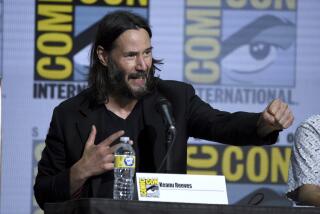‘The City & The City’ by China Miéville
If Philip K. Dick and Raymond Chandler’s love child were raised by Franz Kafka, the writing that emerged might resemble China Miéville’s new novel, “The City & the City.”
Miéville is one of our most talented fabulists, and his work roams boldly across genre, encompassing dark fantasy, science fiction, pulp, horror, Steampunk, Slipstream, Orwellian dystopia and Dickensian social commentary. But Miéville’s astonishingly imagined worlds are uniquely his own, and his ability to create intricate, compelling fiction on a grand scale has drawn raves and awards.
Miéville’s 2007 foray into young adult fantasy, “Un Lun Dun,” was a New York Times bestseller. But he remains best known for a baroque, dense and lyrical trilogy -- “Perdido Street Station,” “The Scar” and “Iron Council” -- set in the world of Bas-Lag and New Crobuzon (a sort of alternate London).
In many ways, “The City & the City” is a stark departure.
Where earlier books were drunk on language, detail, color and character, this novel is gray, chilly and stripped down. Where past books topped 600 pages but left readers hungry for more, this one’s barely 300 and seems about right. And where earlier worlds teemed with khepri, garuda, haemophages, vodyanoi, anophelii, slake-moths and cactacae as well as humans, “The City” seems only a cat’s whisker away from our own.
Readers who fall in love with a fictional world often want the author to keep writing the same book -- with slightly new plots and characters. Publishers may push for that too because there’s a built-in market.
In “The City,” Miéville has done something bolder and braver.
He’s written a detective novel.
You might wonder what new twist Miéville could possibly bring to a genre that already has hundreds of variations, from Agatha Christie “cozies” to James M. Cain’s noir. Sleuths solving mysteries today include vampires, dogs, dinosaurs, ghosts, ancient Romans, medieval knights, middle-aged Botswanan women and septuagenarian Laotian coroners, in addition to the usual suspects.
A fresh spin
But Miéville has found untrammeled turf.
He’s done so not by reimagining the classic detective character but by creating a surreal environment in which his sleuth must operate to solve the murder of a young woman who is found dumped near a bleak housing project on the first page.
Miéville’s protagonist is Inspector Tyador Borlú of the Extreme Crime Squad of Beszel, a fictional city-state that Miéville locates in southeastern Europe. The place is drab, the people glum, the culture a faded pastiche of Ottoman, Slav, Byzantine and Austro-Hungarian Mitteleuropa. It’s a decaying, depressed world reminiscent of the 1949 film “The Third Man,” where shadows, paranoia, secrecy and unseen forces reign.
Then things get really twisty.
Beszel has a ghostly and unacknowledged doppelgänger, a city-state called Ul Qoma that overlaps, or “crosshatches,” with its twin, and it soon becomes clear that the dead girl has come from this mirror place whose very existence is a crime to acknowledge.
Although pathologically intertwined, Beszel and Ul Qoma have distinct cultures, languages, architecture, cuisines, economies, fashions and even colors. Residents of each city grow up having to ignore and carefully “unsee” each other. A dreaded secret police force called “Breach” immediately “disappears” anyone who breaks this immutable law.
Within this Orwellian backdrop, Inspector Borlú must navigate the convoluted borders that separate the two cities and allow himself to perceive what he’s spent a lifetime “unseeing,” “unhearing” and even “unsmelling” (Ul Qoma’s spicy cuisine).
Breaking taboos
The paradox Borlú faces is this: To solve the crime, he must risk violating an even greater societal taboo than murder, one that could trigger his own disappearance.
Miéville is working at a high symbolic level here, but the verisimilitude he injects makes things feel familiar. Inspector Borlú uses Google, e-mail and cellphones. He questions unificationists, nationalists, hip-hoppers and mohawked punkers. Both places grapple with war refugees, UNESCO edicts, black marketeers, gentrification and multinational corporations seeking to exploit the tiny city-states.
The existential story turns metaphysical when Borlú learns there may be a third city, the mysterious Orciny, straddling the cracks and interstices between Beszel and Ul Qoma.
Does Orciny exist? What is Breach? Who killed the girl? Is government involved in a cover-up? As Borlú grapples with these questions, Miéville tells the tale of two cities, which may be his overarching goal anyway, though the plot is resolved satisfactorily by the book’s end.
Like his previous work, “The City” is an unabashed love letter to the diversity, polyglot sprawl, complexities, contradictions, pitfalls, humanity and streetlife of the metropolis. It’s also studded with Miéville’s inventive vocabulary.
A “Fulana” is Besz slang for a “Jane Doe.” Forensic experts are mec-techs because they analyze the mise-en-crime. “Chews” consume an illegal street drug like khat whose fiberglass threads abrade the gums to enter the blood. There are many whimsical touches, such as the DöplirCaffés -- side-by-side Jewish and Muslim coffeehouses with separate kosher and halal kitchens that “share a single name, sign and sprawl of tables.”
Usual and unusual
Miéville mines the tropes of detective fiction -- the murder scene, the coroner’s autopsy, the witnesses who saw nothing, the shadowy government figure and the sidekicks, but the book evokes our own fractured times as well. The sundered cities of Beszel and Ul Qoma contain elements of wartime Sarajevo or Cold War Berlin. The double-speak and disappearances are common to any modern police state. The “unseeing” is exactly how individuals and nations block out unpleasant realities, whether it’s the homeless man on the corner or the latest genocide.
The novel works best when Miéville trusts his storytelling instincts. I was immediately entranced by the premise of doppel cities and didn’t need it explained at every turn.
At times, I appreciated the intellectual brilliance of “The City” more than I lost myself in it. Borlú seemed an archetype more than a fleshed-out character. That’s OK. The real protagonists here are the mirror cities themselves, and the strange inner workings that make them, and their residents, tick.
Hamilton’s latest crime novel is “The Last Embrace,” set in 1949 Hollywood. She is also editor of the short-story anthology “Los Angeles Noir.”
More to Read
Sign up for our Book Club newsletter
Get the latest news, events and more from the Los Angeles Times Book Club, and help us get L.A. reading and talking.
You may occasionally receive promotional content from the Los Angeles Times.






